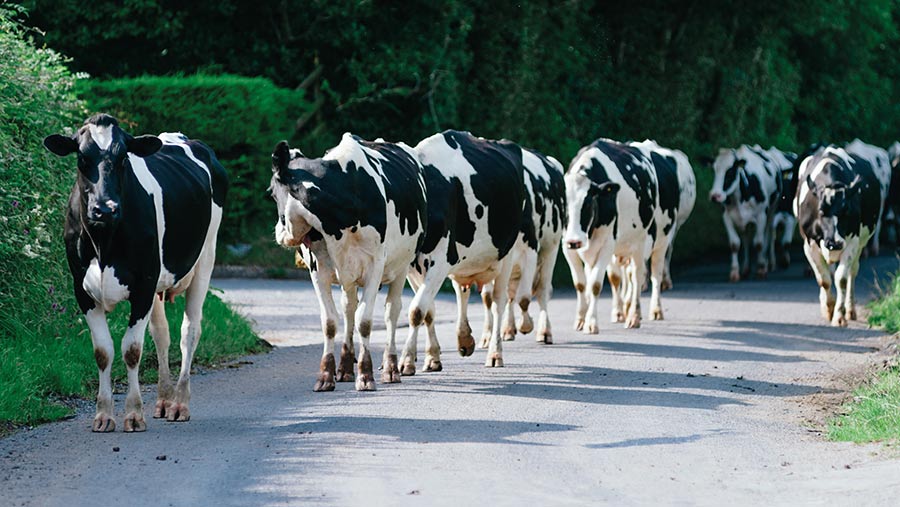How milk testing could help predict lameness in dairy cows
 © Jen Grantham/Stocksy/Adobe Stock
© Jen Grantham/Stocksy/Adobe Stock A study has revealed that sampling and testing milk for specific biomarkers could help farmers predict lameness in dairy cows long before the onset of visible symptoms.
The presence of biomarkers – indicators of a biological state or condition – could enable more prompt, effective treatment.
Research has shown that when lameness is detected and treated early, cows experience fewer severe foot lesions and are less likely to need future treatments. In contrast, where treatment is delayed, the outcome of this treatment is likely to be poorer.
See also: Why genetics can play bigger role in breeding out lameness
Researcher Laura Randall at Nottingham University, who carried out the study, said there were big knowledge gaps in terms of pathogenesis – the progression of a disease – meaning that diagnosis of lameness was largely restricted to visual assessments such as mobility scoring.
However, using metabolomics to identify metabolites (the products of metabolism) within cells, tissues, biofluids or organisms related to lameness could enable earlier intervention.
This is based on the theory that changes in the metabolome, the total number of metabolites present, may be detectable before changes in an animal’s gait.
Prof Randall explained: “The nice thing about metabolomics is that this is a really highly sensitive reflection of phenotypic state – the state of that animal – whether they’re healthy or diseased.”
To test this theory, Prof Randall conducted a study to investigate the potential of using milk samples to detect changes in metabolome as an early indicator of lameness. Milk was used because of its easy, non-invasive collection process.
About the study
Milk samples were collected from the 300-head commercial dairy herd at Nottingham University.
The quarters of 10 lame and 10 non-lame cows were hand-stripped.
All cows were either in first or second lactation and, for the purpose of the research, lameness was defined as a score of 2 or 3 – using the AHDB’s 0-3 scoring system.
AHDB mobility scoring scale
- Score 0 Good mobility – walks with even weight-bearing and rhythm on all four feet, with a flat back.
- Score 1 Imperfect mobility – steps uneven or strides shortened. The affected limb/s may not be immediately identifiable.
- Score 2 Impaired mobility – uneven weight-bearing on a limb that is immediately identifiable, and/or obviously shortened strides.
- Score 3 Severely impaired mobility – unable to walk as fast as a brisk human pace; lame leg easy to identify; very lame.
Source: AHDB
A spot of milk from each sample was then dropped onto a milk spot card. These were air-dried before being stored for eight days in a laboratory.
Samples were then analysed using mass-spectrometry to identify the differences – if any – between the metabolomes of the lame and non-lame cows and so identify which metabolites are likely to be associated with lameness.
The results were also analysed through a methodology called machine learning to test the reliability of the data and the appearance of the metabolites.
Results
The analysis concluded that there were differences in the metabolomes of lame and non-lame cows, meaning it is possible to differentiate between these two groups of cows and detect lameness at a very early stage.
One of these discrepancies involved different levels of fatty acids. “Fatty acids have a function in cell activation, immune response and inflammation, and they seemed to be raised in some cows and lower in others,” Prof Randall explained.
In terms of reliability, four different algorithms were used to access the predictability, all of which gave reliability figures of 95-100%.
Conclusion
Although further work is needed to confirm the application of these findings, Prof Randall said the study showed real viability for using milk samples to diagnose lameness in dairy cows, well before physical symptoms.
She said: “The ultimate goal is to be able to get in there before we get to the point where there is an impact on welfare because we know lameness is a very painful condition.
“[The cows] probably have some sort of pathology there, for a fair period of time, before they get to the point that they’re showing us they’re lame.”
The next stage of the research is to look at other biofluids, including blood and urine, to determine which biomarkers are most effective for detecting lameness. However, so far milk is looking to be the most useful.
“This is very much the start of this work, but this study hopefully underpins what we might see being used in the future,” Prof Randall said. “I see this as the information which will give us the building blocks for the development of objective diagnostic and predictive tools for lameness.
“The other important part of this is that if we can find these informed metabolites, do pathway analysis and track it back, then we could potentially find some really useful information about the pathogenesis of the lesions causing lameness.”
Prof Laura Randall was speaking at the Total Dairy conference on 23-24 November 2022, held at the Crowne Plaza, Stratford-upon-Avon, Warwickshire
